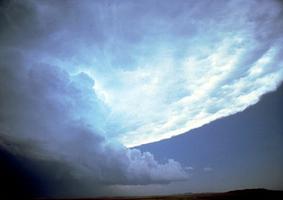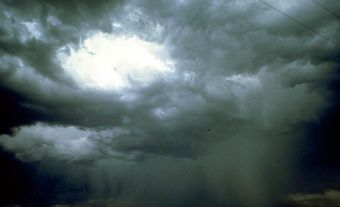Rain is liquid precipitation - precipitation being liquid and solid water that condenses in and falls from the atmosphere. A typical raindrop is about 2 mm in diameter (range, 0.5-5 mm). Almost all rain-producing clouds are formed as a result of upward motion of air charged with water vapour. Such motion produces cooling and subsequent condensation into water droplets and ice crystals. Normally, the crystals melt before reaching the ground. In Canada, rain is usually an event of the warm season. Rainfall is sometimes classified according to the process responsible for the initial lifting of the air. Cyclonic rainfall occurs when moist air converges and lifts in low-pressure (cyclone) areas. This process accounts for much of Canada's rainfall.
Environmental Significance
Central US lows, entering Canada somewhere between Manitoba and Québec, are of major environmental significance because they pass through the industrial heartland of the US and frequently bring acid rain. Frontal rainfall results from the lifting of warm air on one side of a frontal surface (zone separating air masses of dissimilar characteristics) over colder, denser air on the other side. Convective rainfall, caused by warmer air rising in colder surroundings, is sometimes associated with thunderstorms. Orographic rainfall, however, occurs when moist air is lifted over mountains.
Sometimes, especially in early spring and late fall, rain falling through a cloud base may encounter a shallow atmospheric layer extending a few hundred metres above the ground in which the temperature is below freezing. The raindrops are chilled and arrive at the surface as supercooled drops, referred to as freezing rain. When the drops strike objects whose temperature is below zero, they freeze, eventually forming a layer of clear ice.
Classifications
For synoptic purposes, rain is classified as slight if it falls at a rate less than 0.5 mm/h; moderate if the rate is 0.5-4 mm/h; heavy if the rate is greater than 4 mm/h. The heaviest rainfall in Canada occurs along the BC coast, where annual precipitation can exceed 2500 mm. Ocean Falls, BC, has the greatest annual rainfall of 4145.1 mm. Canada's one-day record rainfall of 489 mm fell near Ucluelet on Vancouver Island (6 October 1967). The second zone of high rainfall comprises the Atlantic provinces. Average annual precipitation in parts of NS and Newfoundland exceeds 1500 mm. Occurrences of heavy rainfall in other parts of Canada are frequently associated with the extratropical phase of hurricanes: Hurricane Hazel dumped over 18 cm of rainfall in less than 24 hours in parts of southern Ontario (15-16 October 1954). Arctic regions receive the least rainfall, followed by the southern prairies and the deep valley systems of interior BC. But even in these areas, isolated very heavy rains are not uncommon. For example, 17.8 mm fell in 5 minutes in Winnipeg on 14 July 1968.
The benefits of rainfall are considerable. Rain is a major vehicle through which Canada's freshwater resources are renewed. In many parts of the country, especially in the prairies, crop yield is closely related to the amount and timing of rainfall during the growing season. But very heavy rainfall can cause flash floods and washouts.

 Share on Facebook
Share on Facebook Share on X
Share on X Share by Email
Share by Email Share on Google Classroom
Share on Google Classroom



